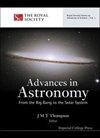Comparison of Decadal Trends among Total Solar Irradiance Composites of Satellite Observations
IF 1.2
4区 物理与天体物理
Q3 ASTRONOMY & ASTROPHYSICS
引用次数: 6
Abstract
We present a new analysis of the two-decade-old controversy over interpretation of satellite observations of total solar irradiance (TSI) since 1978 and the implications of our findings for TSI as a driver of climate change. Our approach compares the methods of constructing the two most commonly referenced TSI composites (ACRIM and PMOD) that relate successive observational databases and two others recently constructed using a novel statistical approach. Our primary focus is on the disparate decadal trending results of the ACRIM and PMOD TSI composite time series, namely, whether they indicate an increasing trend from 1980 to 2000 and a decreasing trend thereafter (ACRIM) or a continuously decreasing trend since 1980 (PMOD). Construction of the four-decade observational TSI composites from 1978 to the present requires the use of results from two less precise Earth Radiation Budget experiments (Nimbus7/ERB and ERBS/ERBE) during the so-called ACRIM-Gap (1989.5–1991.8), between the end of the ACRIM1 and the beginning of the ACRIM2 experiments. The ACRIM and PMOD composites used the ERB and ERBE results, respectively, to bridge the gap. The well-established paradigm of positive correlation between Solar Magnetic Field Strength (SMFS) and TSI supports the validity of the upward trend in the ERB results and the corresponding decadal upward trend of the ACRIM composite during solar cycles 21 and 22. The ERBE results have a sensor degradation caused downward gap trend, contrary to the SMFS/TSI paradigm, that biased the PMOD composite decadal trend downward during solar cycles 21 and 22. The different choice of gap bridging data is clearly the cause of the ACRIM and PMOD TSI trending difference, agreeing closely in both magnitude and direction. We also analyze two recently proposed statistical TSI composites. Unfortunately their methodology cannot account for the gap degradation of the ERBE experiment and their resulting uncertainties are too large to uniquely distinguish between the trending of the ACRIM and PMOD composites. Our analysis supports the ACRIM TSI increasing trend during the 1980 to 2000 period, followed by a long-term decreasing trend since.卫星观测太阳总辐射复合物的年代趋势比较
本文对自1978年以来关于太阳总辐照度(TSI)卫星观测数据解释的争议进行了新的分析,并对TSI作为气候变化驱动因素的影响进行了分析。我们的方法比较了构建两个最常用的TSI复合材料(ACRIM和PMOD)的方法,这些方法涉及连续的观测数据库和最近使用一种新的统计方法构建的另外两个TSI复合材料。我们主要关注的是ACRIM和PMOD TSI复合时间序列的不同年代际趋势结果,即它们是在1980 - 2000年间呈上升趋势,之后呈下降趋势(ACRIM)还是在1980年以来呈持续下降趋势(PMOD)。构建从1978年至今的40年观测TSI复合数据需要在所谓的ACRIM-Gap(1989.5-1991.8)期间(在ACRIM1结束和ACRIM2开始之间)使用两个不太精确的地球辐射预算实验(Nimbus7/ERB和ERBS/ERBE)的结果。ACRIM和PMOD复合材料分别利用ERB和ERBE的结果来弥补这一差距。太阳磁场强度(SMFS)与TSI正相关的模式支持了ERB结果的上升趋势和相应的ACRIM复合指数在第21和第22太阳周期的年代际上升趋势的有效性。与SMFS/TSI模式相反,ERBE结果有传感器退化导致的下降间隙趋势,使PMOD复合年代际趋势在第21和第22太阳周期下降。间隙桥接数据的不同选择显然是导致ACRIM和PMOD TSI趋势差异的原因,在幅度和方向上都非常接近。我们还分析了最近提出的两种统计TSI复合材料。不幸的是,他们的方法不能解释ERBE实验的间隙退化,其结果的不确定性太大,无法唯一区分ACRIM和PMOD复合材料的趋势。分析表明,1980 ~ 2000年ACRIM TSI呈上升趋势,此后呈长期下降趋势。
本文章由计算机程序翻译,如有差异,请以英文原文为准。
求助全文
约1分钟内获得全文
求助全文
来源期刊

Advances in Astronomy
ASTRONOMY & ASTROPHYSICS-
CiteScore
2.70
自引率
7.10%
发文量
10
审稿时长
22 weeks
期刊介绍:
Advances in Astronomy publishes articles in all areas of astronomy, astrophysics, and cosmology. The journal accepts both observational and theoretical investigations into celestial objects and the wider universe, as well as the reports of new methods and instrumentation for their study.
 求助内容:
求助内容: 应助结果提醒方式:
应助结果提醒方式:


